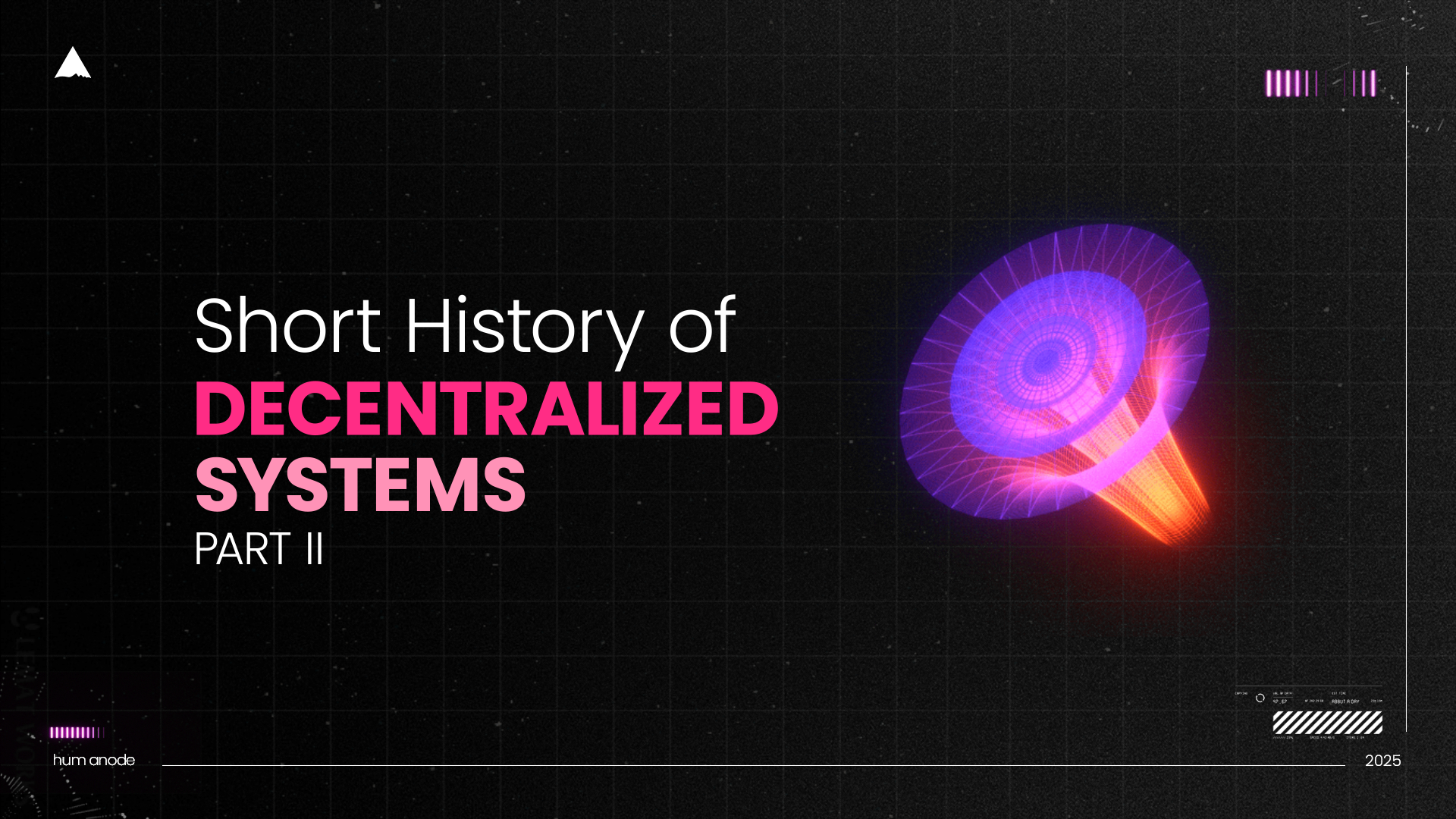A Short History of Decentralized Systems - Part 2

In the first part, we’ve seen decentralization evolve from tribal councils to peer-to-peer file sharing, from Bitcoin’s trustless value transfer to Ethereum’s world computer. We’ve watched DAOs experiment with governance and IPFS decentralized storage. And we’ve seen the same issues resurface:
- Consensus mechanisms rewarding capital over contribution
- Governance models are vulnerable to whales and Sybil attacks
- Digital identity systems lack uniqueness, fairness, and real-world grounding
And this is where Humanode enters the scene. Not as an iteration, but as a departure.
One Human. One Node. One Vote.
Humanode flips the script. Instead of asking: "How much hardware do you own?" or "How many tokens can you lock up?" it asks something radically simple:
Are you a real, living human being?
If yes, you can validate blocks, vote in governance, and share in rewards. If not? No shortcuts. No bots. No fake accounts. No capital advantage.
That’s the core idea behind Humanode’s consensus: Proof-of-Biometric-Uniqueness (PoBU).
What Is PoBU?
PoBU is a Sybil-resistant consensus mechanism that ties each validator to a unique human being through cryptographically secured biometric verification. That means one human, one node, and each node has the same weight. Unlike PoW and PoS, there’s no competition for resources. Your existence is your stake.
This doesn’t mean giving up your privacy. Humanode never stores or sees your biometric data. Instead, your facial scan is encrypted and processed within a Confidential Virtual Machine (CVM), creating a hashed proof of uniqueness. It’s called a Biotoken. Your face never leaves your device, and the Biotoken can’t be reverse-engineered. So, you can prove you're real without revealing who you are.
And this isn’t a one-time process. Every validator must regularly re-authenticate to stay in the network. These liveness checks ensure that validators are still alive and still who they claim to be. If something’s off? That validator is paused. The network isn’t just decentralized, it’s dynamic and breathing.
A Network of Humans, Not Machines
In Humanode, wealth can’t buy you more power. You can’t stake your way to dominance or spin up multiple nodes. Each human gets one voice. Rewards are distributed equally. Voting is one-person-one-vote. No whales. No validator cartels. Just people. That’s the breakthrough.
And that egalitarian vision runs deep. Unlike traditional blockchain fees that fluctuate with speculation, Humanode uses a cost-based transaction model. Fees are pegged to actual compute and storage costs and shared equally among active validators. It’s predictable. It’s rational. And it makes running a node sustainable, even for those with modest means.
Vortex Governance: From Tokenocracy to Cognitocracy
Governance is handled through Vortex, Humanode’s DAO. But forget token-based voting. Here, proposal power is earned through contribution, uptime, and participation. It’s called cognitocracy: governance by commitment and track record, not capital.
All human nodes have equal voting rights, but higher-tier privileges (like proposal submission) are unlocked through reputation, measured by Proof-of-Time and Proof-of-Devotion. That means even the newest validator has a say, and those who show up consistently help shape the future.
The Biometric Marketplace
Humanode 1.0 doesn’t stop with facial recognition. It’s just the beginning. The protocol is designed to evolve into a multimodal biometric system, incorporating modalities like voice, iris, gait, and eventually even brain-computer interfaces. This layered approach ensures even greater uniqueness and resilience against biometric fraud.
To make this work at scale, Humanode will introduce the Biometric Marketplace. It allows multiple biometric providers to plug into the network, all running inside CVMs to ensure data privacy. This marketplace prevents vendor lock-in, enables fallback in case of failure, and opens the door to a diversity of algorithms and approaches. Every provider must meet strict standards and operate in hardware-isolated enclaves, meaning biometric verification stays private, secure, and user-verifiable.
Since the mainnet launch in 2022, the Humanode network has grown to over 1,800 uniquely verified validators, with no downtime. But this is just the start. The goal for Humanode 1.0? Reach 10,000 human nodes. Not just to hit a number, but to prove that true decentralization is possible when the validator set mirrors real-world humanity.
Every new node makes the network more secure, more inclusive, and more resistant to capture. Because in Humanode, power isn’t accumulated, it’s distributed.
And if we can build a network of 10,000 real humans, what’s stopping us from reaching a million?
One human. One node. One vote.
That’s not just a slogan. It’s the foundation for the era of decentralized coordination.
Comparing the Engines of Decentralization
As we've seen, decentralization wears many masks. Some systems are built to store files, others to move money, and some to reimagine how humans organize themselves. But despite the diversity, there are shared challenges they all try to solve: trust, identity, control, and coordination.
Let’s break it down, not as a dry table, but as a story of systems and the philosophies behind them.
Peer-to-Peer Swarms: Trust in the Crowd
Early systems like peer-to-peer file sharing and distributed computing projects didn’t rely on consensus at all. They leveraged human altruism or swarm logic:
- Swarm protocols (like P2P file sharing) scaled beautifully. More users meant more capacity.
- There was no need to agree on a single source of truth. Each peer just shared pieces of data.
- Governance? None. Control was in the protocol, and in whoever ran a tracker or hosted a list.
Identity didn’t matter. You were just a peer. There was no token, no name, no need to verify who you were. But that also meant zero Sybil resistance. Anyone could be anyone, or everyone.
Distributed Computing: Power Through Idle Cycles
Volunteer computing projects added structure. A central coordinator farmed out tasks to idle computers. Results were checked for consistency by duplication. But again, identity was loose. Contribution was the metric, not uniqueness.
Consensus mechanisms? Not needed.
Proof-of-Work: Consensus Through Cost
Then came decentralized money. To solve double-spending, one system introduced Proof-of-Work (PoW). It asked nodes to burn electricity by solving puzzles. The first one to solve a block won the right to record history. Everyone else verified it.
Security came from cost. To cheat, you’d need more power than the rest of the network combined. But that cost created problems:
- Environmental impact
- Hardware monopolies
- Wealth accumulation
And identity? Still pseudonymous. No way to tell if one miner was actually thousands.
Proof-of-Stake: Consensus Through Wealth
To fix PoW’s inefficiencies, others turned to Proof-of-Stake (PoS). Here, validators stake tokens to propose and verify blocks. It’s more efficient. But influence is tied to capital.
More stake = more power.
This improved energy use but made Sybil attacks cheaper if you're rich. You can spin up wallets, delegate stake, and sway governance, because wallets aren’t humans.
Smart Contracts and DAOs: Logic Becomes Law
When programmable smart contracts entered the picture, coordination changed again. Now you could encode rules: funds move only if conditions are met. DAOs were born, decentralized orgs run by token votes and on-chain code.
But token-voting governance replicated old hierarchies:
- Token-rich whales controlled outcomes
- Bots could farm airdrops
- Real humans were indistinguishable from Sybils
Decentralized? On paper. Democratic? Not really.
Distributed Storage and Identity
File storage systems used content addressing, no blockchain, just cryptographic hashes. Want a file? Ask the network for its hash. If someone has it, you get it. No central server needed.
Identity? Minimal. Peers are just nodes with public keys.
Meanwhile, Decentralized Identifiers (DIDs) emerged to give people portable, verifiable identities across apps. But unless you tied a DID to a real person, nothing stopped Sybil farms from creating thousands.
Proof-of-Biometric-Uniqueness: Consensus Through Humanity
Instead of staking tokens or burning energy, one protocol asked a radical question: Can we build consensus on the fact that you're a real, unique, living human being?
With Proof-of-Biometric-Uniqueness (PoBU), each validator proves they are one person, biometrically, privately, and cryptographically.
- No staking.
- No mining.
- No whales.
- No bots.
Just humans.
Each node is equal. Each vote is equal. Each reward is equal.
Summing Up
From file storage to governance, messaging to money, identity to infrastructure, we’re slowly building decentralized systems that don’t just scale... they represent. Systems where the participant isn’t a machine, or a wallet, or a line of code.
It’s a person.
The next leap in decentralization isn’t about faster blocks or cheaper fees. It’s about anchoring trust in human existence and designing systems that reflect that.
Let’s see where that takes us next.

